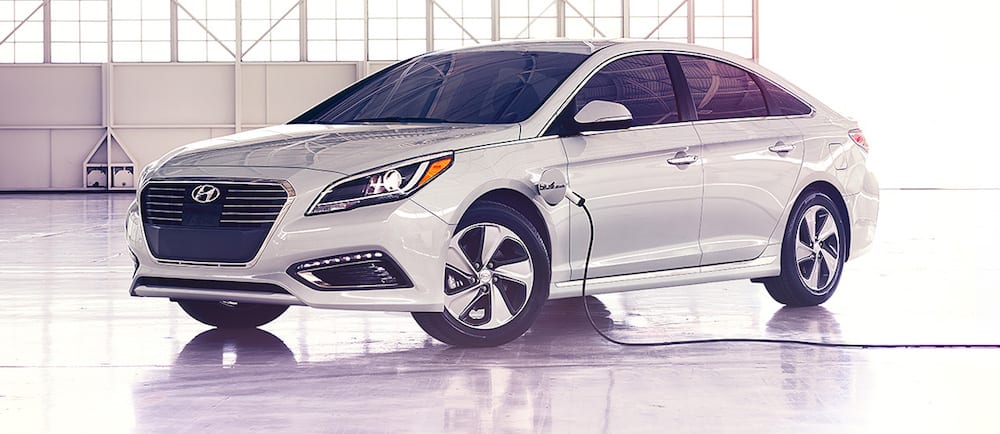Hyundai car dealers have recently seen the new 2016 Sonata Hybrid roll into their lots, which also comes with a plug-in electric variant. When it comes to the new Sonata Hybrid, the real question is to plug-in, or not to plug-in? The models have both similarities and differences, some good, and some bad. They both offer unique driving experiences, and choosing one to drive might be difficult if you don’t know what a plug-in electric hybrid is.
What is a Plug-In Electric Hybrid?
It’s exactly as the name suggests, these plug-in cars have two different types of powertrains that can drive the wheels. There is an electric engine that can go for a certain distance, and then the gas engine kicks in once the electric motor is depleted. The straight electric cars only have an electric motor, and can’t be driven when the electric motor runs out of power.
There are two different kinds of Plug-in hybrids, series plug-in hybrids and parallel or blended plug-in hybrids. The series plug-in hybrids only use the electric motor to turn the wheels, the gas engine kicking in after the electric motor has run out.
The parallel/blended plug-in hybrids have the gas and electric motor mechanically connected to the wheels. Both of the engines propel the vehicle down the road, the electric-only operation occurring at lower speeds.
How it Works
The Sonata Plug-in Hybrid would be considered a series-plug in hybrid, since Hyundai states that their hybrid relies more on electric-only operation to deliver extended driving range and mpg. The battery system in the Sonata plug-in offers the option to plug into a household electrical outlet, providing a convenient power source to recharge.
If that’s too much of a hassle, it also allows you to switch over to hybrid mode on the go to charge the electric motor. On the highway, it uses just the gas engine in order to recharge the electric motor even faster.
The Engine
There is only one engine being offered for both types of Sonata, and the electric motor varies in power. The standard hybrid engine is a new 2.0-liter four-cylinder engine paired with a 51 electric horsepower motor, while the plug-in has a 67 electric horsepower motor.
The 2.0-liter gets a peak 154 horsepower and 140 pound-feet of torque on its own. Combined, the horsepower of the standard hybrid is 193 horsepower, and the plug-in gets 202 horsepower. Thanks to the stronger electric motor provided in the plug-in.
Fuel-Economy
Thanks to the new engine, fuel-economy has improved from the 2015 Sonata. The standard hybrid is rated at 40 mpg city and 44 mpg highway (39/43 for the heavier limited model), while the plug-in gets 40 mpg combined when running on just gas. For the plug-in, the electric motor has a range of 27 miles.
Combined, this makes for a total of up to 600 miles when using the gas and electric motor to drive around.

Performance
You are still looking at a hybrid car so I wouldn’t get too excited, but it’s still decent enough. The standard hybrid goes from 0-60 mph in 8.1 seconds, run of the mill for most hybrids. But, things are exciting for the plug-in variant. It’s considered to have more oomph than any other plug-in hybrid on the market. Beating out models like the Ford Fusion Energy and the Honda Accord Plug-in Hybrid in terms of performance.
Choosing to Plug-In
The plug-in hybrid’s starting MSRP is a costly $34,600, that’s almost 10 grand more than the standard Hybrid that pops in at $26,000. The idea behind the Sonata plug-in hybrid (and all others for that matter) is that the fuel economy saves money in the long-run. Using electricity is cheaper than using gasoline; and since the plug-in has the capability to swap between the two, you will be saving more fuel overall.
Going Greener
The standard hybrid produces less emissions than a conventional vehicle, therefore the plug-in produces even less. Since the standard hybrid model doesn’t have the capability to fully utilize the electric motor for a certain amount of time, it can’t reduce as much as the plug-in. When you let the plug-in’s electric engine fully take over, you are reducing harmful emissions for that set amount of time.

I’ve Got the Power!
Literally, you’ve got the power. This is a blessing and a curse, because the electric motor helps reduce harmful emissions and save on the cost of fuel, but there is a recharge time. Using a 120-volt household electrical outlet can take the Sonata plug-in up to 9 hours to fully charge. While this may eat up some time, you still have the ability to run it on gas if you want to. You just won’t see the reduction in emissions or savings in fuel that you see while trading off between the gas and electric motor. Also, the vehicle won’t be able to reach its maximum combined range of 600 miles.
Opting Not to Plug-In
Choosing to buy the conventional Sonata hybrid will get you almost a $10,000 dollar reduction in price, but also a reduction in power.
Less Ponies
Because of the stronger electric motor in the plug-in, the standard hybrid has less oomph than the plug-in model. That 0-60 mph in 8.1 seconds that is considered the best for a plug-in car is just “meh” when it comes to the standard hybrid, the description matching the sound it makes when you hit the gas.
Tires, They Matter
The standard hybrid can only use 16-inch aluminum alloy wheels, and If you want bigger wheels, you will need to spend the extra 4 grand to get the Hybrid Limited. At that point, you are up to the 17-inch wheels that come standard on the plug-in model. Tire size does make a difference; if you have bigger tires there are less rotations, which means a reduction in engine usage.
This means you save fuel, even if it’s only slightly, with bigger tires. It also affects the stability and traction of your car, but it’s a double-edged sword. You end up paying more for a bigger tire if it needs to be replaced.
Size
Unfortunately, the bigger battery in the plug-in model causes you to lose some interior space. So, if you want as much storage area as possible get the standard hybrid model. The amount of passenger room remains the same, but the cargo room is what ends up suffering. In the standard Hybrid, you have 119.4 cu. ft. of cargo space. While the plug-in only gets 116.0 cu. ft. of space. It might not seem like much, but every little bit helps when it comes to cramming for a road trip.
The Results?
If you are looking for a hybrid that has better overall fuel-economy and more power, go for the plug-in electric. If you feel like you would be inconvenienced waiting for your car to charge up for optimal performance, go with the standard hybrid. As far as other features go, they are relatively the same. You get the same type of interior and exterior features/designs, and that only begins to vary if you go up to the limited editions.
No matter which one you choose, you will be getting at least 40 mpg combined. That stellar fuel-economy is almost necessary with the way todays gas prices ebb and flow.




